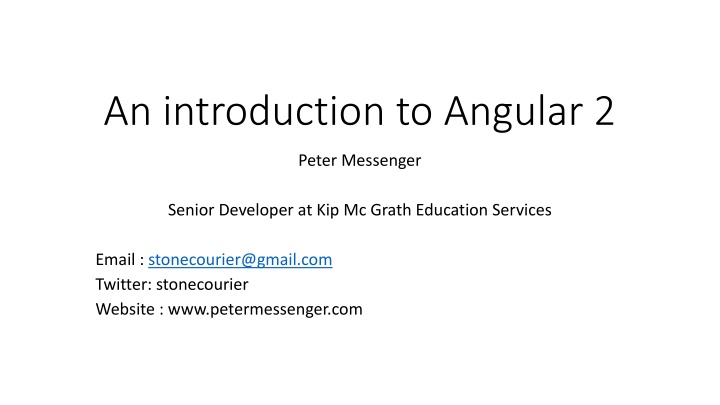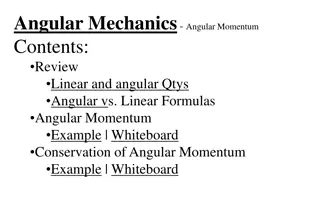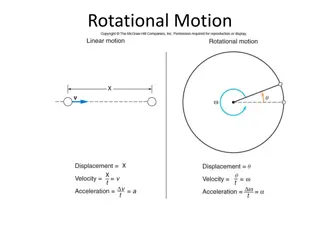Angular 2 Overview and Benefits
Angular 2, developed by Google using TypeScript, is a popular JavaScript framework known for creating web and native applications. This post explores its features, benefits, development history, and the application being worked on by Peter Messenger. Learn about TypeScript advantages, components, and the transition from Angular 1.
Download Presentation

Please find below an Image/Link to download the presentation.
The content on the website is provided AS IS for your information and personal use only. It may not be sold, licensed, or shared on other websites without obtaining consent from the author.If you encounter any issues during the download, it is possible that the publisher has removed the file from their server.
You are allowed to download the files provided on this website for personal or commercial use, subject to the condition that they are used lawfully. All files are the property of their respective owners.
The content on the website is provided AS IS for your information and personal use only. It may not be sold, licensed, or shared on other websites without obtaining consent from the author.
E N D
Presentation Transcript
An introduction to Angular 2 Peter Messenger Senior Developer at Kip Mc Grath Education Services Email : stonecourier@gmail.com Twitter: stonecourier Website : www.petermessenger.com
My Development History Lots of work with C#, HTML and JavaScript Originally worked on webforms Moved on Single Page applications (Knockout JS) Worked on developing Silverlight Applications Worked on MVC apps, JQuery front ends Worked with Typescript extensively Presented a coders on Windows Phone, Android, Silverlight, Knockout, MVVM, JQuery Mobile/UI Typescript, Nativescript + more
Application I am working on Teaching portal, setting up and doing lessons collaboratively Kids (5 years and up) People with reading or learning difficulties Approximately 650 centres around Australia 40,000+ students per week Also other countries England, New Zealand, Singapore etc Technology Angular 2 Front End Dev Express Components Socket IO, Video conferencing functionality ASP NET core web api back end Replacing JQuery/JavaScript Front End Mix of lots of libraries MVC Back end
What is Angular 2? Angular 1 was originally developed in 2009 Angular 2 rewrite was originally started in Sept 2014 Released after long beta testing in Sept 2016 Very popular JavaScript framework for creating web applications Can also be used to develop native apps using Nativescript, Ionic framework etc Developed by Google using Typescript (a typed subset of javascript from Microsoft)
Benefits of Angular 2 - Typescript Compile time type checking, intellisense export interface IListItem { someText: string; someNumber: number; someDate: number; arrayOfStrings: string[]; } export class AppComponent { listItems: IListItem[]; }
Typescript Classes, Interfaces, Enums, Functions Inheritance, Generics Private, Public, Protected Namespaces, Modules Changes JavaScript for the better (more like C#) Personally, Do not want to develop vanilla JavaScript ever again. See more at https://www.typescriptlang.org/
Benefits of Angular 2 Complete framework for developing apps Components building blocks for apps Input, Output Templates Services (http and more) Dependency Injection Observables Routing, Forms and Modules (skipping explanation of these in this presentation) Get more information at https://angular.io/docs/ts/latest/guide/
Benefits of Angular 2 - Components Develop components promotes clean testable code import { Component } from '@angular/core'; @Component({ selector: 'my-app', template: `<h1>Hello {{name}}</h1>` }) export class AppComponent { name = 'Angular'; }
Benefits of Angular 2 - Events @Component({ selector: 'my-app', template: `<button (click)= sayHello() ></button>` }) export class AppComponent { sayHello() { alert( Hello); } }
Benefits of Angular 2 - Input export class AppComponent { @Input() name = 'Angular'; } Can pass in data from the html <my-app name= some other name ></my-app> Can also do binding <my-app [name]= myBoundVariable ></my-app> Can also do two-way binding <my-app [(name)]= myBoundVariable ></my-app>
Benefits of Angular 2 - Output export class AppComponent { @Output() onSpecialEvent: EventEmitter<string> = new EventEmitter<string>(); specialEvent(value: string) { this.onSpecialEvent.emit(value); } } Can pass in data from the html <my-app (onSpecialEvent)= myCustomHandler($event) ></my-app>
Benefits of Angular 2 - Templates Inline @Component({ selector: 'my-app', template: ` <h1>{{title}}</h1> <h2>My favorite hero is: {{myHero}}</h2> `}) File Reference (my preference) @Component({ selector: "kip-enrolment- wizard", templateUrl: "enrolmentwizard.html", styleUrls: ["enrolmentwizard.css"], })
Benefits of Angular 2 - Templates Binds the presence of the CSS class extra-sparkle on the element to the truthiness of the expression isDelightful Binds style property width to the result of expression mySize in pixels The safe navigation operator (?) means that the employer field is optional and if undefined, the rest of the expression should be ignored. <div [class.extra- sparkle]="isDelightful"> <div [style.width.px]="mySize"> <p>Employer: {{employer?.company Name}}</p>
Benefits of Angular 2 Templates continued Removes or recreates a portion of the DOM tree based on the showSection expression. Turns the li element and its contents into a template, and uses that to instantiate a view for each item in list. <section *ngIf="showSection"> <li *ngFor="let item of list"> <div [ngSwitch]="conditionExpression"> <template [ngSwitchCase]="case1Exp">...</te mplate> <template ngSwitchCase="case2LiteralString">. ..</template> <template ngSwitchDefault>...</template> </div> Conditionally swaps the contents of the div by selecting one of the embedded templates based on the current value of conditionExpression. See more at https://angular.io/docs/ts/latest/guide/cheatsheet.html
Benefits of Angular 2 Services/Injectable Can make helper service classes These can provide a data access layer via http (these work really well with ASP NET core web api) Can use observables (can subscribe to monitor changes) someVariable.subscribe((changes)=>{}); Can use promises soSomething(action).then((result)=>{}); Anything you can think of These can be injected into your components Makes it easy to mock and test
Benefits of Angular 2 Services/Injectable import { Injectable } from '@angular/core'; import { Hero } from './hero'; import { HEROES } from './mock-heroes'; export var HEROES: Hero[] = [ { id: 11, isSecret: false, name: 'Mr. Nice' }, @Injectable() { id: 12, isSecret: false, name: 'Narco' }, export class HeroService { { id: 13, isSecret: false, name: 'Bombasto' }, getHeroes() { return HEROES; } { id: 14, isSecret: false, name: 'Celeritas' }, } { id: 15, isSecret: false, name: 'Magneta' }, { id: 16, isSecret: false, name: 'RubberMan' }, ------------------------ { id: 17, isSecret: false, name: 'Dynama' }, export class HeroListComponent { { id: 18, isSecret: true, name: 'Dr IQ' }, heroes: Hero[]; { id: 19, isSecret: true, name: 'Magma' }, constructor(heroService: HeroService) { { id: 20, isSecret: true, name: 'Tornado' } this.heroes = heroService.getHeroes(); ]; } }
Benefits of Angular 2 Observables & State Observables Uses RxJs to simplify asynchronous code Observables, Promises and more Almost a complete presentation in itself State Libraries like ngrx/store allow you to manage the entire state of your application simply https://github.com/ngrx/store
Visual Studio Code Use Visual Studio Code (free) https://code.visualstudio.com/ Built in Git Hub integration Plugins help write better code TS Lint helps developers write better code you can turn on/off rules to suit your coding style
Quick Code Demo Showing NCG Demo
Compiling your Application An Angular application consist largely of components and their HTML templates. Before the browser can render the application, the components and templates must be converted to executable JavaScript by the Angular compiler. You can compile the app in the browser, at runtime, as the application loads, using the Just-in-Time (JIT) compiler. JIT compilation incurs a runtime performance penalty. Views take longer to render because of the in-browser compilation step. The application is bigger because it includes the Angular compiler and a lot of library code that the application won't actually need. Bigger apps take longer to transmit and are slower to load. Compilation can uncover many component-template binding errors. JIT compilation discovers them at runtime which is later than we'd like.
Ahead of Time Compilation Faster rendering With AOT, the browser downloads a pre-compiled version of the application. The browser loads executable code so it can render the application immediately, without waiting to compile the app first. Fewer asynchronous requests The compiler inlines external html templates and css style sheets within the application JavaScript, eliminating separate ajax requests for those source files. Smaller Angular framework download size There's no need to download the Angular compiler if the app is already compiled. The compiler is roughly half of Angular itself, so omitting it dramatically reduces the application payload. Detect template errors earlier The AOT compiler detects and reports template binding errors during the build step before users can see them. Better security AOT compiles HTML templates and components into JavaScript files long before they are served to the client. With no templates to read and no risky client-side HTML or JavaScript evaluation, there are fewer opportunities for injection attacks.
Treeshaking Making application smaller Tree shaking is the ability to remove any code that we are not actually using in our application from the final bundle. It's one of the most effective techniques to reduce the footprint of an application. You may think all my code is being used! Third party libraries Redundant code etc Done using Webpack 2. Can be included as part of the build process Very easily done using
Angular Command Line Interface Use angular cli (command line interface) https://github.com/angular/angular-cli Automatic change detection, can just change code while you are developing and your browser will automatically be refreshed Built in commands to create components, directives etc Run karma tests Run full project linting Automates build process Ahead of time compilation Copies all the files you need to make deployment easy Joins all the files together and tree-shakes your code to make it a small as possible Automates css/js compression
Angular Cli Getting Started npm install g angular-cli ng new new-app cd new-app ng serve Other Commands ng generate . (components, routes, services) ng build -- prod ng build -- dev
Angular Cli build output Creates file with guid names based on if content has changed Makes caching easy Splits up scripts (your code, reference libraries etc) Can make it include files as required Copy to server and it will just work
Component Frameworks Many component vendors Telerik - http://www.telerik.com/kendo-angular-ui/ Wijmo - http://wijmo.com/angular2/ Dev Extreme - https://www.npmjs.com/package/devextreme-angular Material - https://material.angular.io/ Most are still a work in progress We are currently using Dev Extreme (as they are reusing their old code base, they are more complete)
Quick Demo of Application Demonstrate Speed Translation Services Security
Questions? Presentation will be up on my site www.petermessenger.com Looking for employment Want to work on Angular 2 Project? Come and see me, Kip McGrath is hiring.























